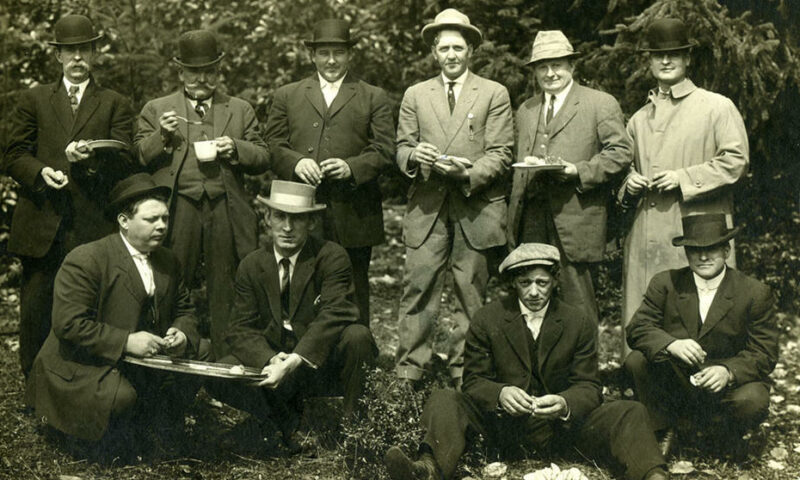(Pictured: A clambake in approximately 1910 in Fairfax included these gentlemen. Washington State Historical Society
By Knute Berger
Cascade PBS
According to the Haida First Nations people of the northern British Columbian coast, the origins of humanity began on a beach. Raven found a large clam shell and noticed some creatures protruding from it and squirming inside. He coaxed the reluctant creatures to come out and join the rest of the world. They were the first men.
It seems apt that a clam shell would be part of an origin story in the coastal Pacific Northwest. Thousands of years of shell middens — old refuse deposits — are testament to shellfish’s role in sustaining people here. The variety and abundance of clam shells show they were a crucial source of food, proof of the old adage “When the tide is out, the table is set.” Let’s hear it for the quiet, unsung — well, barely sung — bivalve, the clam.
The receding of the glaciers left behind a pleasant homeland for shellfish. Clams were accessible on sandy beaches. On Haida Gwaii, the Haida’s island homeland, people were living sustainably on game and shellfish nearly 11,000 years ago, not long after the ice retreated and Raven coaxed humanity into the daylight. Indigenous people throughout the Northwest dug for clams, carrying special clam baskets and using digger sticks to chase them down. Many middens were the result of processing large numbers of clams, which were often smoked and dried for later consumption or trade. Dried and smoked clams made their way over the mountains. People far from the sea could still enjoy some briny goodness.
The cultivation of clam beds by Indigenous people is one phenomenon that is being revived. Many Native peoples made “clam gardens.” Some argue the term is a misnomer because the gardens involved a variety of techniques and serious heavy lifting. Shorelines were re-engineered to expand sandy beaches. Rocks were removed to increase clam habitat. Walls and revetments were erected to improve cultivation. Aquaculture here is thousands of years old.
Another, more local, origin story involving clams relates to the beginnings of modern Seattle. The Denny Party, Euro-American settlers credited with starting the city, landed at Alki Point on a chilly, wet November day in 1851. They marked a new wave of settlers on Puget Sound. Among the party was a baby, Rolland Denny, just two months old. His mother, Mary Ann, was sick and couldn’t produce milk, so Duwamish women taught her to nurture tiny Rolland on clam broth until she could. It worked. He lived to be 87 years old, the last survivor of the original Denny party.
Restaurateur Ivar Haglund capitalized on clams and kept the virtues of clam broth — or clam nectar — on menus with a winking suggestion that it might be an aphrodisiac. But he also promoted an old frontier song that said that the abundance of clams was the essence of the good life in Puget Sound country — especially for those not prosperous in farming, prospecting or any other frontier endeavor. Haglund named his Seattle waterfront restaurant Acres of Clams.
In the 1860s, when the Washington Territory stretched as far east as Idaho, western Montana and a bit of Wyoming, political observers in the eastern parts felt a division of power between east and west. Today, people might complain about the Cascade east/west divide, but back in the day they grumbled about the politicos throwing their weight around in “clam country,” their epithet for Olympia-dominated politics.
No clam is more identifiable or as great a conversation piece than the geoduck, a Lushootseed word that relates to the clam’s prodigious digging abilities (it can go deep) and because of an appendage that can’t fit into its shell and can extend up to three feet. It’s the clam’s “neck” through which it breaths and siphons sand and water. The geoduck is considered a delicacy and is used in sushi, among other things.
And then there is chowder. In the Northwest, the popular version that caught on was creamy New England-style chowder — back in the day the region was not known for tomatoes, the basis of Manhattan-style clam chowder. Food historian Jacqueline Williams says that by the 1880s, New England-style recipes began appearing in the first local cookbooks. Territorial cooks could reliably come by more ingredients, like flour, thanks to shipments from back east, and it’s a damp-weather, gut-warming tonic.
Clams are the symbol of steady, contented existence. They’ve been feeding us for thousands of years — long after they attended our birth on a beach.
Source: Crosscut, part of Cascade PBS, a non-profit news site covering the Pacific Northwest. Knute Berger is editor-at-large for Crosscut.

